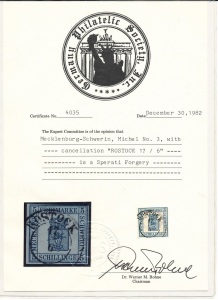While Francois Fournier was a philatelic facsimile maker whose work fools only novices or collectors who have never seen the real thing, Jean de Sperati spent his life creating forgeries designed to undermine the most knowledgeable philatelists. Even his book that he wrote Philatelie sans Experts (Philately without Experts) shows his prime motivation was the thrill of creating forgeries that even great experts couldn't tell. And Sperati's work is good, so good, in fact that until about 1920, when it became known that he was doing forgeries, stamps that he made in his workshop would routinely get certificates of genuineness from the most prestigious certifying boards. Sperati's work was a passion. He engraved his stamps from scratch—a process that took months. He bought sheets of genuine stamps (of cheaper values in a set) so that he could use the selvage for printing his forgeries so that the paper and watermark would be the same as the original. Indeed, one wonders that he bothered at all as the financial gain from producing his work must have been less than his costs and his time, certainly the time of as fine an artist as he was. Herbert Bloch, the great stamp expertiser, famously said that experts never determine genuineness per se, that all an expert can do is compare a specimen against all known forgery types. Sperati, until he announced himself to the philatelic world, had done all his work unknown to philately. And his forgeries were in the finest collections.
Jean de Sperati forgery business was ended in a manner similar to the way Francois Fournier's forgery business was ended. Because Sperati never forged current issue stamps or stamps that had not been demonitzed, it was difficult to bring counterfeiting charges against him (or fraud charges either—the charge of defrauding collectors of revenue was difficult to prove because Sperati always wrote on the back of each of his stamps "Reproduction de Jean de Sperati" lightly, in pencil). The Royal Philatelic Society of London (RPS) established a fund to buy Sperati's plates and stock. The plates were defaced and the stock destroyed and a wonderful limited edition of Sperati's work was issued by the society including cuts of all the stamps that Sperati still had had plates for and which the RPS had bought.
The way in which Sperai's work was handled after he was shut down mirrored the handling of Fournier (and also Roaul De Thuin). While alive and active they were excoriated, feared and reviled. After their stocks were purchased and their plates defaced they have been honored and admired. Each of the three had a coffee table sized book of their life work produced. The stories of their work and the shutting of their doors became one of the great achievements of the Swiss Federation, the RPS, and American Philatelic Society, respectively. Perhaps organized philately's interest in the story and the demise of these three great philatelic forgers is a bit like the excitement felt by a great game hunter. The fear and loathing of the world's largest tiger is assuaged by stuffing the carcass and putting it on your wall.

